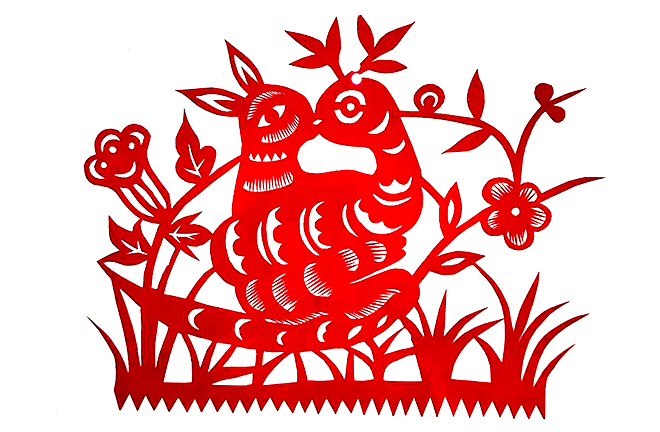Snake carries rich implications in Chinese culture

“Snake Coiling Around Rabbit,” a traditional Chinese paper cutting by Pei Xiaoqi Photo: Ren Guanhong/CSST
As 2025 ushers in the Year of the Snake, it brings renewed attention to China’s longstanding snake culture. From ancient totem worship and folk customs to myths, legends, and artistic representations, the snake embodies rich cultural meaning and serves as a source of emotional resonance for the Chinese people. To mark the beginning of this zodiac year, CSST spoke with experts and scholars from various disciplines to explore the historical underpinnings and unique charm of the snake culture in China.
Origins of snake culture
The snake, or she in pinyin, is the sixth animal in the 12-year Chinese zodiac cycle, symbolizing wisdom, flexibility, and rebirth, among other qualities. Xiao Fang, a professor from the School of Sociology at Beijing Normal University, explained that in Chinese folklore, the snake is often called the “lesser long” [dragon] and is usually regarded as a close relative or incarnation of the long. Despite its aggressiveness, the snake holds a special place in traditional Chinese culture, as it is known for controlling rodent populations.
In ancient China, the day and night were divided into 12 time periods, each associated with a zodiac animal and corresponding to a modern two-hour span—a system known as the Chinese zodiac time. Yang Shuming, a distinguished research fellow at the Shaanxi Provincial Academy of Social Sciences, noted that the period from 9 a.m. to 11 a.m. was called Si Shi [Si Hour]. During this time, the morning fog would lift, the sun would warm the earth, and snakes would emerge from their holes to forage. Because of this behavior, snakes were also referred to as “Si She.”
As an ancient and widespread creature, the snake gradually became an object of worship due to its distinctive survival instincts and remarkable vitality. Yang emphasized that in traditional Chinese culture, Fuxi and Nüwa, mythological figures with human upper bodies and serpentine tails, are regarded as the earliest ancestors of humankind. Ancient people held the snake in awe and veneration, leading many tribal rulers to cut or manipulate snakes in rituals meant to demonstrate their power, thus turning these acts into mysterious religious ceremonies.
Over time, despite their fear and reverence, people began to worship the snake as a totem, Yang continued. Archaeological discoveries, such as snake-adorned pottery jars from the Stone Age, suggest that before the long evolved into its iconic form, the snake was widely revered by early Chinese ancestors.
Diverse cultural expressions
The archaeological representation of the snake is typically simple and clear, retaining the primitive elements of totem worship and cultural beliefs. In contrast, literary and artistic portrayals of the snake integrate people’s life experiences and emotional expressions, rendering the animal’s image more vivid, tangible, and distinctive.
Shi Aidong, a research fellow from the Institute of Literature at the Chinese Academy of Social Sciences, highlighted that in the Chinese classic Shi Jing (The Book of Poetry), dreams involving snakes are seen as auspicious signs of fertility. In the popular folktale “The Legend of the White Snake,” Madame White Snake embodies an advanced form of the snake deity, symbolizing maturity, beauty, and generosity, while her sister, the Green Snake, represents vigor, spiritedness, and the journey toward maturity. These works not only enrich the cultural significance and expression of the snake but also reflect the diverse interpretations within Chinese snake culture.
Various snake-related folk customs express people’s desires for prosperity and harmony. Xiao noted that as early as the Han Dynasty, there were folk art performances featuring “playing with snakes.” Although this practice has faded over time, traditions persist in places like Zhanghu, in Fujian Province, where the annual snake lantern parade during the first lunar month and the snake-playing rituals at the Snake God Temple on the seventh day of the seventh lunar month remain vibrant local ceremonies. In Shandong Province, during the Spring Festival, locals shape dough into snake forms and place them in barns as prayers for a bountiful year.
The evolution of the snake as a cultural symbol reflects humanity’s reverence for nature, contemplation of life, and enduring pursuit of a better existence. Through cultural inheritance and innovation, Chinese snake culture continues to flourish and shine with renewed brilliance.
Edited by CHEN MIRONG
